Royal Wulff Fly : How to Ties this Remarkable Dry Fly
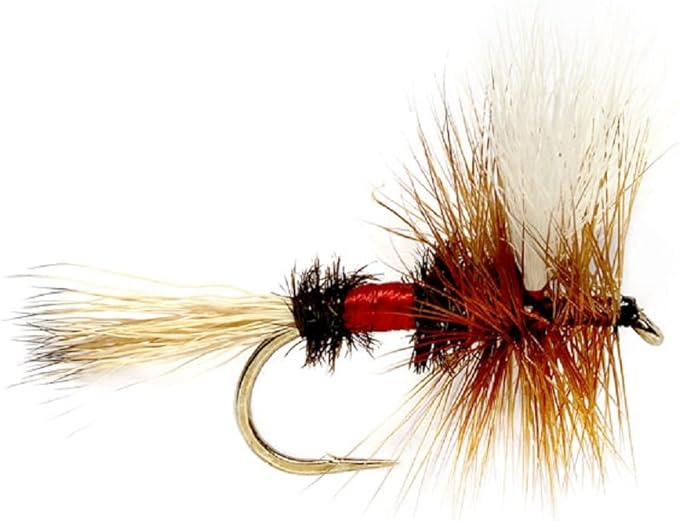
I can hardly contain my excitement as I introduce you to the world of the Royal Wulff Fly. This fly is an absolute classic, a must-have in your tackle box, and a real game-changer when it comes to fly fishing.
In this blog post, we’ll delve into the specifics of what makes the Royal Wulff Fly so unique, the steps to tie one, and tips for using it effectively.
What Makes Royal Wulff Flies Special?
Unlike some other flies that copy specific bugs, Royal Wulff Flies are different. They’re like eye-catching decorations that grab a trout’s attention.
They don’t pretend to be one bug in particular; instead, they stand out with their bright colors and lifelike movements.
So, what’s cool about these flies? First off, they’re super easy to see. Their red bodies and white wings make them stand out, even in fast-moving water.
This is great, especially for beginners who might struggle to spot other, more subtle flies.
Another neat thing about Royal Wulff Flies is that they float well. Even in rough waters, they stay on the surface, making them even more visible to hungry trout.
And they’re tough too! They can handle lots of bites from trout without falling apart, so you can use them again and again.
Characteristics of the Royal Wulff Fly
Royal Wulff fly stands out from the crowd thanks to a unique combination of features that mimic different insects in nature.
First up, let’s talk about its hair wing.
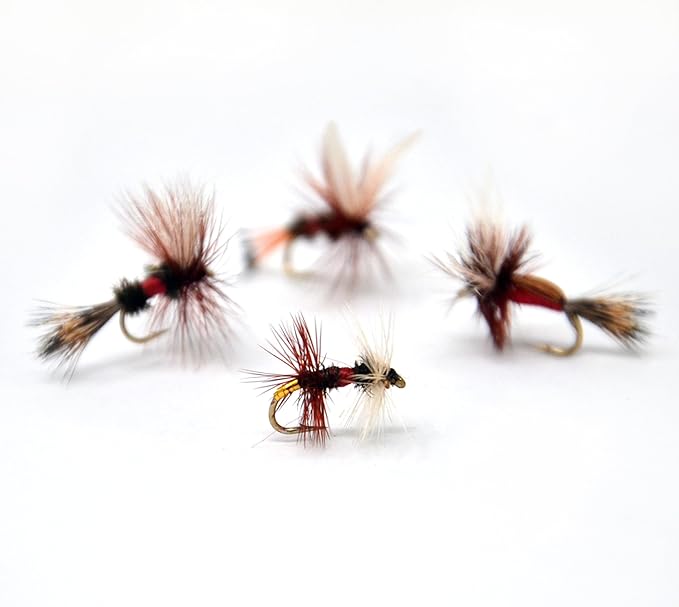
Typically made from deer or elk hair, this part of the fly adds something special: buoyancy.
This means it can float easily on the water’s surface. Plus, the hair wing looks like a real flying insect, which fish find hard to resist.
Now, onto the body. It’s made from peacock herl, giving the fly a shiny, lifelike appearance. This not only looks good but also mimics the natural flash of real insects, making it super tempting for fish to bite.
Lastly, there’s that striking red band running across the body. This isn’t just for show. The color red is like a magnet for fish, drawing their attention. Plus, it helps the fly stand out for us anglers too.
And let’s be honest, it adds a touch of class to the whole fly, making it a favorite among fly fishermen.
How to Tie the Royal Wulff Fly – Step-by-Step Guide

Tying your own Royal Wulff flies can be a rewarding experience and allows you to customize the fly to your preferences. Here is a step-by-step guide on how to tie the Royal Wulff:
Material
- Hook: Dry fly hook (sizes 10-18)
- Thread: Black or brown thread (size 6/0 or 8/0)
- Wing: Deer or elk hair
- Tail: Moose or deer hair
- Body: Peacock herl
- Hackle: Brown or grizzly hackle
Let’s break down the steps for tying the Greenwells Glory spider:
Step-by-Step Guide
- Step 1. Start by attaching the thread to the hook shank and create a smooth thread base.
- Step 2. Select a small bunch of deer or elk hair for the wing. Trim the butts and tie the hair in on top of the hook shank, extending slightly beyond the hook bend.
- Step 3. Trim a small clump of moose or deer hair for the tail. Tie it in on top of the hook shank, just in front of the wing.
- Step 4. Take 3-4 strands of peacock herl and tie them in at the base of the tail. Wrap the herl forward to create the body of the fly, securing it with thread wraps.
- Step 5. Select a brown or grizzly hackle feather and tie it in at the base of the body. Make 4-6 wraps of hackle around the body, securing it with thread wraps.
- Step 6. Finally, Trim any excess hackle and whip finish the fly.
With these simple steps, you can create your own Royal Wulff flies that are ready to be tested on the water. Experiment with different sizes and variations to find what works best in your fishing conditions.
When and Where to Use the Royal Wulff Fly
First off, this fly is great for dry fly fishing, where you want your fly to sit on the water’s surface like a real insect. Its buoyancy and large size make it perfect for this job.
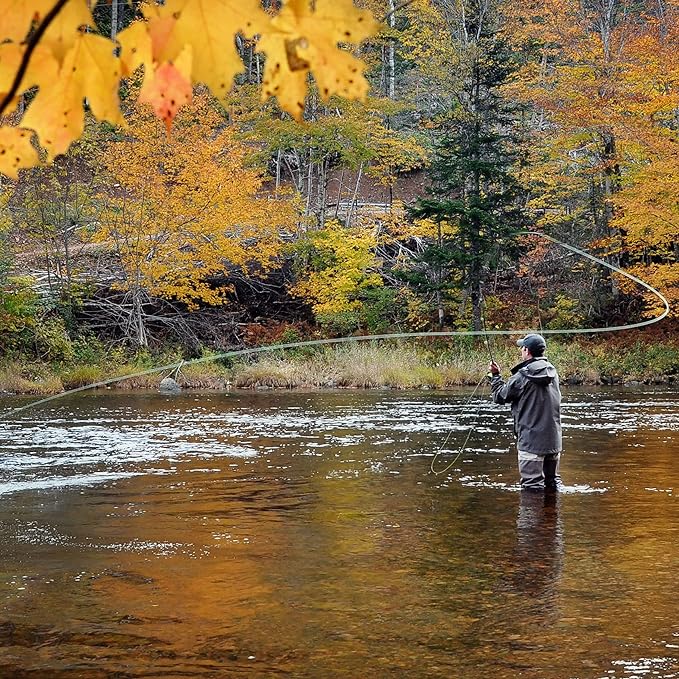
Picture it imitating insects that have just hatched or fallen onto the water.
A prime time to whip out the Royal Wulff is during a hatch when insects are buzzing around or popping up from the water.
The fly’s hair wing and bright red band make it super easy for fish to spot, so they can’t resist snapping it up during these feeding frenzies.
You’ll find the Royal Wulff particularly handy in fast rivers and streams. Its buoyancy helps it float smoothly, even in rough water.
And it’s versatile too, mimicking different insects like mayflies, caddisflies, or even grasshoppers, so you can use it all season long.
Remember, when you’re using the Royal Wulff, pay attention to the size and color of the fly.
Match it to the insects hanging around in the water, and you’ll up your chances of hooking a big one.
So, whether you’re in a fast river or during a hatch, this fly’s got you covered.
Tips and Techniques for Fishing with the Royal Wulff Fly
To maximize your success with the Royal Wulff, here are some tips and techniques to keep in mind:
- Master the Presentation: Focus on presenting the Royal Wulff with a gentle, natural drift. Avoid dragging the fly by skillfully adjusting your line and using reach casts to extend your drift.
- Observe the Water: Before casting, take a good look at the water. Spot rising fish, observe feeding patterns, and check for insect activity. Understanding these cues will help you pick the right size and color of the Royal Wulff to use.
- Experiment with Retrieves: While the Royal Wulff is primarily meant for dry fly fishing, don’t be afraid to mix things up. Try twitching or skating the fly to mimic a struggling insect. Sometimes, this can trigger aggressive strikes from fish.
- Fish Confidently: The Royal Wulff has a solid reputation for success. Trust in its ability to attract fish, and fish with confidence. A confident angler is more likely to make precise casts and detect subtle strikes.
- Keep an eye on the fly: The high visibility of the Royal Wulff allows you to easily track its movements on the water. Watch for any subtle movements or pauses, as these can indicate a fish taking the fly.
Remember, fishing with the Royal Wulff is not just about catching fish; it’s also about enjoying the process and immersing yourself in the art of fly fishing.
Take your time, observe the water, and savor the moments spent on the river.
Variations and Modifications of the Royal Wulff Fly
Over the years, various modifications and variations of the Royal Wulff have been developed to suit different fishing conditions and preferences. Here are a few popular variations:
- Parachute Royal Wulff: Instead of the traditional hair wing, this version sports a parachute-style wing. The parachute design offers better visibility and flotation, making it perfect for rough or fast-moving water where traditional flies might struggle.
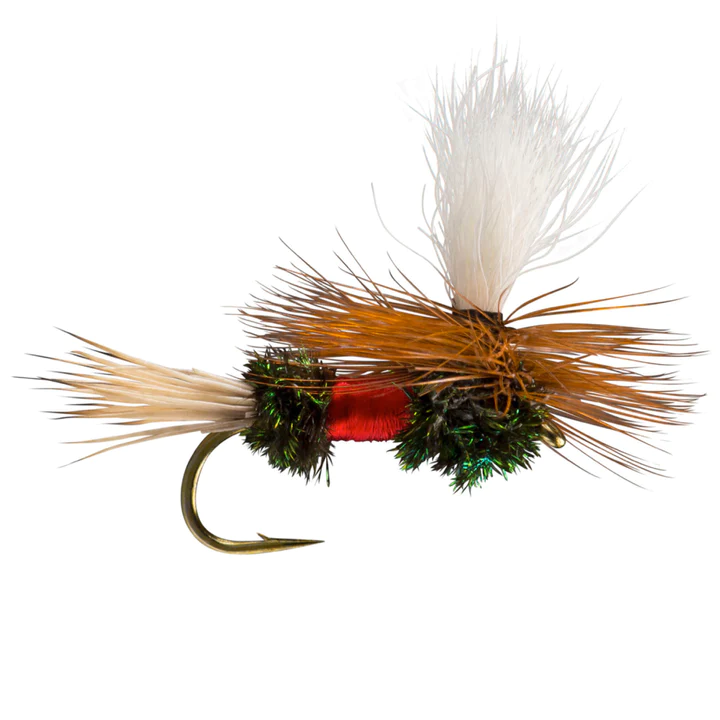
- Royal Wulff Adams: Combining features of both the Royal Wulff and the Adams fly, this variation mimics a wide array of insects. With its hair wing, peacock herl body, and grizzly hackle, it’s a versatile choice for imitating different bugs found in the water.
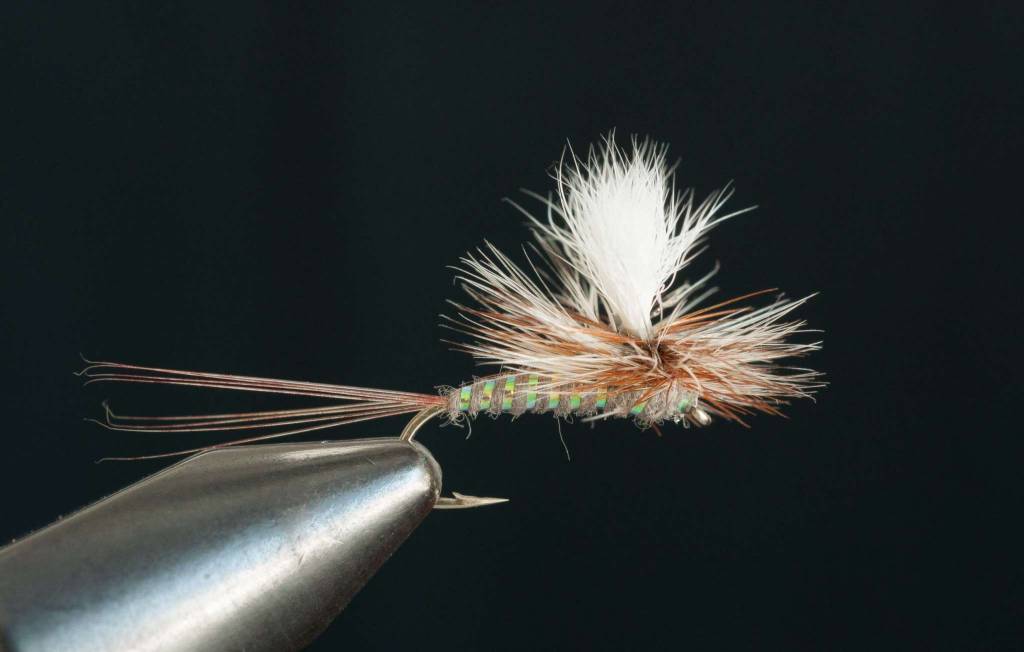
- Royal Trude: Adding a trailing tail made of calf or moose hair sets this modification apart. The extra tail enhances movement and realism, making it a top pick for imitating stoneflies or larger terrestrial insects.

- Royal Humpy: This variation beefs up the body with more hackle, making it larger and providing extra buoyancy. It’s ideal for fishing in strong currents or when targeting aggressive fish that demand a more substantial offering.
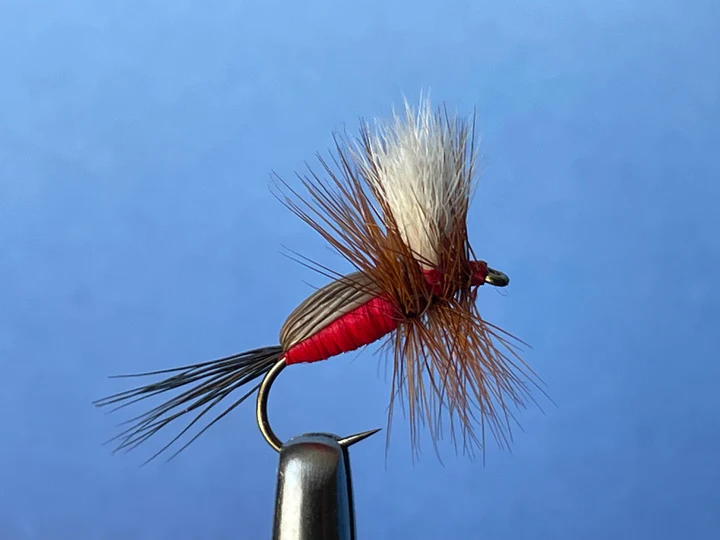
These tweaks allow anglers to tailor the Royal Wulff to specific fishing conditions or target different fish species.
Experimenting with these variations adds excitement and adaptability to your fly-fishing adventures, ensuring you’re always prepared for whatever the water throws your way.
Conservation and Ethical Considerations When Using the Royal Wulff Fly
As responsible anglers, it’s essential to consider conservation and ethical practices when using the Royal Wulff fly, or any other fly for that matter.
Here are a few considerations to keep in mind:
- Embrace Catch and Release: Whenever possible, opt for catch and release, especially for native or endangered species. This helps maintain healthy fish populations and ensures sustainable fishing for future generations to enjoy.
- Handle with Care: Treat every fish with respect. Wet your hands before handling to protect their slime layer, minimizing stress and the risk of injury. Keep the fish out of the water for as little time as possible and support its body properly to prevent harm.
- Know and Follow Regulations: Take the time to understand and adhere to local fishing regulations. These rules are in place to safeguard fish populations and their habitats, ensuring their long-term health and sustainability.
- Respect Fellow Anglers: When fishing in busy areas, show consideration for other anglers. Avoid overcrowding or disturbing their fishing spots unnecessarily. Practice good etiquette, maintain a friendly demeanor, and foster a cooperative atmosphere.
- Keep an eye on the fly: The high visibility of the Royal Wulff allows you to easily track its movements on the water. Watch for any subtle movements or pauses, as these can indicate a fish taking the fly.
By prioritizing these conservation and ethical considerations, you play a vital role in preserving fish populations and the environment, guaranteeing the enjoyment of fly fishing for generations to come.
Why Beginners Love Royal Wulff Flies
If you’re new to fly fishing, the Royal Wulff Fly is a good choice for you. It’s perfect for beginners like you. Wondering why? Let’s take a closer look!
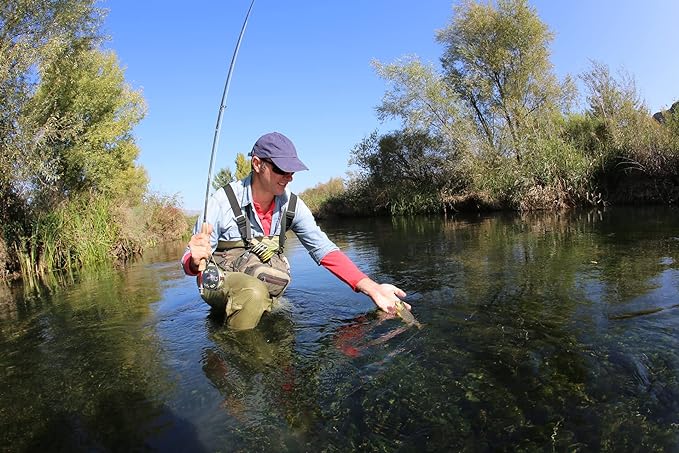
Firstly, tying a Royal Wulff Fly is super easy. You don’t need fancy materials or complicated steps. It’s like doing a fun craft project!
But wait, there’s more! This fly is easy to see on the water because of its bright colors and how it moves. You won’t struggle to spot it amidst the ripples.
And because it floats well, you can focus on improving your casting and reeling skills.
Here’s the best part: you can use the Royal Wulff Fly anytime. It doesn’t imitate a specific insect, so you don’t have to worry about matching what’s hatching. It’s designed to catch trout’s attention no matter what.
For beginners, these features make the Royal Wulff Fly a top choice. It’s simple to tie, easy to use, and it works great for catching trout.
Plus, there’s nothing quite like seeing a trout bite on a fly you made yourself! So go ahead, give the Royal Wulff Fly a try. You’ll love it for sure!
Success Stories and Testimonials of Using the Royal Wulff Fly
The Royal Wulff has a long-standing reputation as a highly effective fly for catching trout, salmon, and other freshwater fish.
Countless anglers have experienced success with this iconic fly and have shared their stories and testimonials. Here are a few notable examples:
“I was fishing a fast-paced river in Montana when I tied on a Royal Wulff. Within minutes, I had a beautiful rainbow trout on the line. The fly’s visibility and buoyancy helped me track the drift and detect the subtle take. It’s now a staple in my fly box.”
John, Montana
“I recently went on a fishing trip to Alaska and used the Royal Wulff exclusively. It was incredible how many fish I caught using this fly. The large profile and realistic silhouette seemed to drive the fish crazy. I highly recommend it to anyone fishing in Alaska.”
Sarah, Alaska
“I have been fly fishing for over 30 years, and the Royal Wulff is one fly that has never disappointed me. It has consistently produced fish for me in various fishing conditions, from small streams to large lakes and ponds. It’s a classic fly that every angler should have in their arsenal.”
David, Colorado
These success stories and testimonials highlight the effectiveness and versatility of the Royal Wulff.
Anglers of all skill levels and fishing destinations have experienced the thrill of hooking into fish using this iconic fly.
Final Thoughts on the Royal Wulff Fly
The Royal Wulff is a special fly loved by fishermen all over the world. Its bright colors, unique design, and how well it works make it a favorite for catching fish like trout and salmon. You can use it in many different fishing spots.
We’ve talked about where this fly comes from and how to make it. We’ve also shared tips on when and where to use it and how to fish with it. There are lots of ways to change the Royal Wulff to make it your own.
Listen to other fishermen’s stories about how they’ve caught fish with this fly. It shows how good it is.
Remember, fishing isn’t just about catching fish. It’s about enjoying nature and casting your line. The Royal Wulff fly brings elegance and success to your fishing trip.
Next time you go fishing, bring some Royal Wulff flies. Tie one on your line, cast it out, and enjoy connecting with nature and the fish. Happy fishing!

Meet Ibrahim Khan, an avid angler and author in Fishing Teach. He shares his wealth of knowledge from his 16 years of experiences in fishing. His articles are a captivating blend of practical insights and thrilling tales that invite readers into the enchanting world of fishing.
Ibrahim’s guides are your go-to guide in the realm of fishing on this informational site. Hailing from a coastal paradise, Ibrahim’s passion for angling is the heartbeat of his life.
